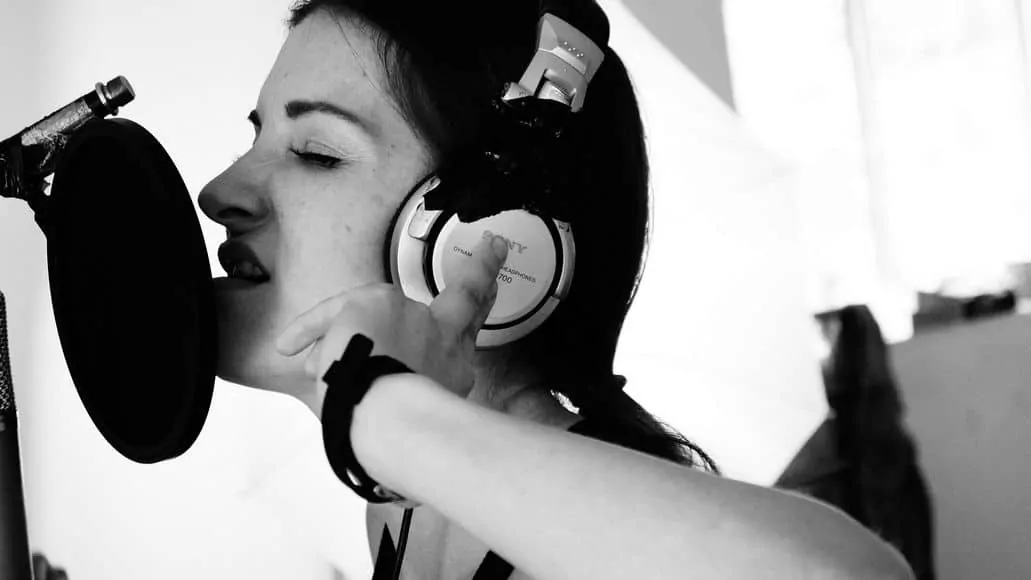
But for most of us, our voice cracks when we go too high and it seems impossible.
I’m here to tell you it is very possible, no matter who you are.
It is true that everyone’s voice is unique and that there is a natural limit to how high you can go
But even someone with a naturally very low voice can learn to sing higher notes.
Moreover, you can learn to do so without any more effort than singing lower notes or even than just speaking.
If you’ve been struggling with high pitch singing, here are some tips and exercises that will get your voice into those higher octaves, without having to get a tonsillectomy.
Table of Contents
How To Sing High Notes Without Straining
Before we begin, I want to stress the importance of warming up. You need to warm up your voice every time you sing.
This is especially true when you are working on higher notes. If you do not warm up properly, you risk causing damage to your voice. Here are some warm-up exercises to follow.
Be Aware Of Your Natural Limits
Not everyone is Whitney Houston or Axl Rose or any of the famous black female singing divas from the 1970s. Just because your favorite singer can hit a certain note with ease, that does not mean you can.

We could practice running and increase our top speed, but no matter how much we try, we will never be as fast as Florence Griffith-Joyner or Carl Lewis. Similarly, you can increase your range and hit higher notes than you are currently able to sing (that’s the whole point of this article, after all), but we all have a natural limit.
The first step in singing higher is to be aware of you abilities and set your goals accordingly.
Let’s take a look at the natural ranges for the different voice types, with the highest note being the one singers with that voice type can hit comfortably. That means it is possible to go higher, but it will take work. Remember: these ranges are just approximations.
Female Voice Types
- Soprano: ranges from C4 (middle C) C6 (high C)
- Mezzo Soprano: ranges from A3 to A5
- Alto: ranges from G3 to F5
- Contralto: ranges from F3 to E5
Male Voice Types
- Tenor: ranges from C3 to C5
- Baritone: ranges from F2 to F4
- Bass: ranges from E2 to E4
As mentioned, the highest notes in these ranges are the notes you should be able to hit comfortably. If you can’t, never fear. The exercises below will help you get there.
If you can hit those notes, and even some higher ones, the exercises below can help you extend that range a little. Just remember to be realistic. If you are a baritone, you are not going to be singing in the 6th octave.
Relax and “Let Go”
The key to singing high notes is surprisingly simple: you just need to relax and let it happen.
Most people push their voice and really force it when they sing high notes. This works, but it decreases the quality of your voice and also wears it out more quickly.
Instead you want to relax and let your brain and vocal cords handle everything on their own. They’re very good at it. To hit high notes, your vocal cords need to stretch long and thin and the easiest way to do that is to let your brain handle it.
Since you’re working on singing higher, I’m going to assume you have the basics down. By that I mean: you know how to stand properly, how to breathe and how to position your mouth and tongue.
If not, head here for tips or here for help on finding singing lessons.
Now that you’re breathing properly and your facial muscles are relaxed, you’re ready to sing some high notes.
The easiest way to do this is to think about letting go. As you sing your notes, simply think to yourself that you’re letting go. Your brain will take over from there and lengthen your vocal cords for you. There is no need to force them.
Here are some exercises to practice this.
The Lip Trill
The lip trill is a great exercise to help you practice singing in a higher pitch. Basically, you blow air through your lips to make them vibrate, then begin humming while doing that.
Keep trilling your lips for a bit, then slowly go higher. As you increase the pitch, think to yourself that you are letting go and allow your brain to take over and lengthen your vocal cords.
I know this probably sounds a bit confusing, but here is a great video that demonstrates this technique and also talks about letting go.
Mmming And Aahhhhing
This is another great exercise. Begin by making an “mmmmmm” sound and make sure to project it forward and not just hold it in the back of your head. Keep your voice toward the bottom of your range.
Still at the bottom of your vocal range, open your mouth and switch from the “mmmmmm” sound to an “aahhhh” sound, while maintaining the same resonance.
Now move higher up the scale, switching from “mmmmm” to “aahhhh” for each note. Once you get to the higher notes, try not to focus on the notes and how high they sound, but on the resonance in your head. Remember to tell yourself to let go.
The Ng Sound
The best register to use when singing high notes is the mixed voice, which is a combination of your head voice and chest voice. The two exercises above should have forced you to go into the mixed voice, but if this is something you struggle with, try using the Ng sound.
The Ng I am referring to is the sound found at the end of the word ‘sing’. Go ahead and say that word a few times, then drop the first two letters, so that you are only making the final Ng sound.
Now choose a pitch you are comfortable singing and sing a rising scale of 6 to 8 notes, then go back down to the beginning, making the nasal Ng sound on every note. Try to keep the Ng sound consistent as you climb the scale.
Try Practicing Your Song
The previous three exercises help get you more comfortable singing in your mixed voice. They help keep you in that mixed voice register even as you go into higher notes. Since you’re not actually singing any real words, but simply sounds, it is easy to go higher, without thinking about it. You stay relaxed.
Once you’ve gotten good at hitting the note you want to hit using the previous three exercises, it is time to go back and try the actual song. Isolate the phrase with the problem note and give it a try.
If you find you still can’t get it, even though you were able to hit that note when doing the sounds, it may help to simply replace the words with one of those sounds. Or even several different sounds. Sing it on one first, then try another. Make up your own sounds.
The point is to sing the problem phrase without having to worry about the words. Get that down first. Then add the words again. If you’re still not getting it, try lowering the pitch a few notes, until you can easily sing it.
Now increase the pitch a quarter note and sing the phrase again. Do it a few times until you find it easy. Then increase the pitch another quarter note. Keep increasing it and practicing until the new pitch is easy, until you reach the original key.
How To Hit Higher Notes: Additional Tips
The following are a few simple tips that may help, if you find yourself committing on, or more, of these common mistakes.
Don’t Reach For The Note
A very common mistake is to stretch your head and neck upward when singing a higher note. It just seems like the natural thing to do: to reach higher when trying to go higher.
But it’s actually a big problem.
Stretching your neck upward restricts your windpipe and creates tension in your throat, which makes it more difficult to hit the note you’re aiming for.
If you find yourself doing this, make a conscious effort to keep your head and neck level and facing forward, but not pointing forward. In other words, they should be balanced in their natural position above your shoulders, not straining in any direction.
Don’t “Push Off” Toward The Note
This is very similar to the last point and the two often happen at the same time. “Pushing off” refers to the tendency to stand up on your toes and lift your shoulders, in an apparent effort to get yourself higher and thus closer to the note.
Obviously, this does not work. Worse, it creates tension in your body that inhibits your ability to hit the note. You need to stay relaxed and part of that is keeping both feet firmly beneath you and your shoulders in their natural position. If you struggle with the correct singing posture, read this article.
Don’t Beat Yourself Up
Extending your range and singing higher notes is difficult. You are not going to get that note just right on the first, or second, or even 50th time. This can be frustrating, but becoming frustrated and beating yourself up only increases tension and anxiety, making it impossible to hit the note.
If you find yourself getting frustrated with your inability to hit the note, try lowering the pitch on the song you are singing to the point where you can hit the note easily. Sing it in that pitch a few times to boost your confidence.
Then increase the pitch of the song slowly, a quarter note at a time. Keep increasing it gradually. This way you can build up your strength and eventually, you will find yourself singing the song, and hitting that problem note, in the original key.
Always Take Care Of Your Vocal Cords
In addition to not straining them, you also want to keep your vocal folds well-hydrated. Do this with water (ideally room temperature). Add some honey and/or lemon for flavor, if you like. Stay away from alcohol, milk, caffeinated drinks and sugary drinks.
You also want to eat the right foods. Some foods can irritate your vocal cords and make it harder to sing. This article covers what to eat and what not to eat.
Singing High Notes: Final Thoughts
The first few times you do the exercises to help you sing higher, they may seem difficult (as well as weird). Keep practicing and pretty soon, you will be able to sing high notes without straining. Once you’ve got it down, those notes will come out effortlessly, just like speaking.



I’m having a very hard time doing the lip trill. How can I learn to do it?
Great tips and advice from a mental as well as physiological perspective. I sing 7 nights a week with my job, but from a seated position as I’m a piano vocalist. My absolute upper limit is G5, once, in Rocket Man, but I find that many male vocalists from more recent years tend to sing consistently in the 5-6 octave and I struggle to understand how or even why.
Good stuff! Especially warming up, I tend to be impatient and rush myself, but when I actually take the time to lip trill my songs and pratice range extension, everything’s so much better ~ haha go figure 🙄
Thanks for writing!🤙🕺
Thanks, I’m glad you found it useful!
Great Tips
Thank you!